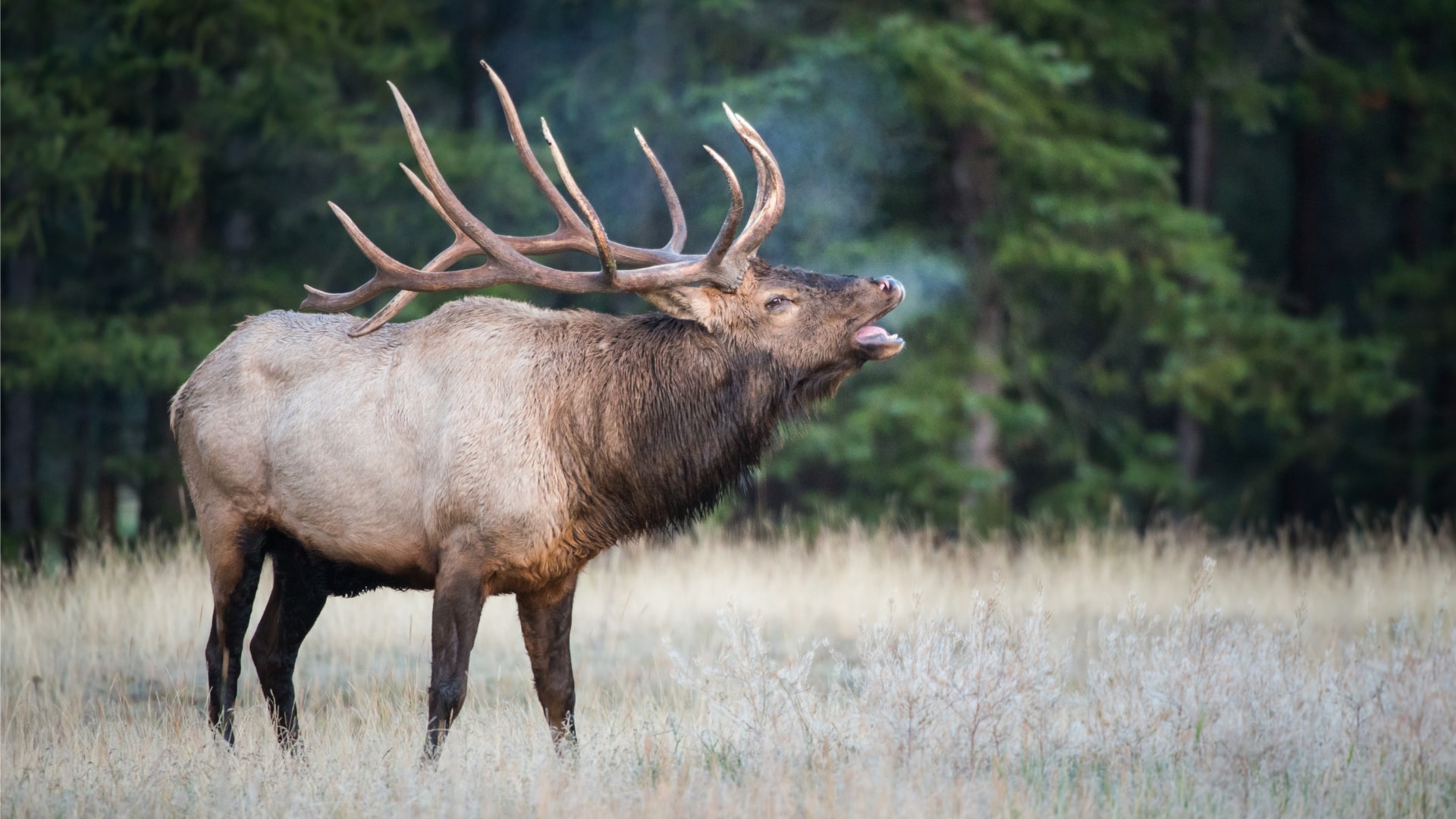Physical Characteristics
Elk (Cervus canadensis), also known as Wapiti, are one of the largest species of deer found in North America. Adult males, or bulls, can weigh between 500 and 1000 pounds and stand up to 5 feet tall at the shoulder. Females, or cows, are smaller and typically weigh between 350 and 550 pounds. They have long, slender legs and a distinctive tan coat with a dark mane and white rump patch. Their antlers are large and impressive, with multiple branches or points.
Behavior
They are social animals that typically live in herds, although they may also form smaller groups or live alone. Usually they are active during the day and spend much of their time grazing on grasses, shrubs, and other vegetation. During the breeding season, known as the rut, bulls will compete for the right to mate with females, often engaging in spectacular displays of dominance.
Habitat
Elk can be found throughout much of North America, from Canada to Mexico. They are adapted to a variety of habitats, including forests, mountains, and grasslands. In the summer, they may migrate to higher elevations to escape the heat, while in the winter they may move to lower elevations to find food and shelter.
Diet
They are primarily herbivores, feeding on a variety of plants including grasses, sedges, and shrubs. They are also known to eat bark, twigs, and leaves from trees and bushes, particularly in the winter when other food sources are scarce.
Breeding
Elk mate in the fall, with the breeding season lasting from late August to early October. During this time, bulls will compete for the attention of females, often engaging in displays of strength and aggression. After mating, cows will give birth to a single calf in the spring or early summer.
Ecological Role
As herbivores, they play an important role in shaping plant communities by consuming and dispersing seeds, and controlling the growth of certain plant species. They also provide a food source for predators such as wolves, mountain lions, and bears.
Elk Hunting
Elk hunting is a popular activity in North America, with many hunters seeking out this majestic animal for sport and for food. Elk hunting requires skill, patience, and preparation. In some states, a hunting license and tags are required, and hunters must follow strict regulations and guidelines to ensure ethical hunting practices and conservation of the species.
Elk hunting season typically runs from late summer to early winter, depending on the state and the specific hunting unit. Hunters can use various hunting methods, including archery, rifle, muzzleloader, or even a handgun. Hunting techniques can vary, with some hunters using spot-and-stalk methods, while others prefer to call or rattle in elk.
One of the challenges of hunting elk is the animal’s keen sense of smell and hearing, making stealth and scent control essential. Hunters often use scent-blocking clothing and gear to minimize their scent, and they may also use decoys, calls, or other attractants to lure elk into range.
Ethical hunting practices are important to ensure the conservation of elk populations. Hunters must follow regulations regarding bag limits, hunting methods, and reporting requirements. Many hunters also engage in conservation efforts, such as supporting habitat restoration projects or donating to organizations that work to protect and manage elk populations.
Tracks & Signs
Elk tracks are large and distinctive, similar to those of deer but more massive. Each track typically measures around 4 to 5 inches (10.2 to 12.7 cm) in length. Elk have cloven hooves with two toes that form a pointed shape at the front. Dew claws are often seen in soft soil, snow, and when running.
Elk scat, or feces, is a common sign of their presence. It is typically oval-shaped and resembles those of other deer species but larger. Fresh scat may have a moist appearance, while older scat becomes drier and more crumbly.
Conservation
Elk were once hunted to near extinction in some areas, but conservation efforts have helped to restore their populations. Today, elk are still facing threats such as habitat loss, disease, and climate change. Conservation efforts include habitat protection, population monitoring, and disease management.
Did You Know?
Elk are excellent swimmers and are not deterred by bodies of water.
They can gracefully navigate rivers and lakes, using their strong legs and buoyant bodies to stay afloat. Swimming allows them to access new habitats and escape predators.
Elk are considered a keystone species, meaning they have a significant impact on the ecosystems they inhabit.
Their grazing patterns help shape vegetation growth, creating open spaces that benefit other wildlife species. They also disperse seeds through their droppings, contributing to plant diversity.
Image sources: Winterberry Wildlife, AZ Animals





